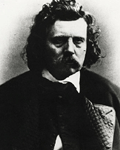엠마누엘 로이체(Emanuel Gottlieb Leutze)FOLLOW
1816년05월24일 독일 슈베비슈 그뮌트 출생 - 1868년07월18일
엠마누엘 로이체(Emanuel Gottlieb Leutze)FOLLOW
1816년05월24일 독일 슈베비슈 그뮌트 출생 - 1868년07월18일

추가정보
Leutze was born to a Jewish family[citation needed] in Schw?isch Gm?d, W?ttemberg (Germany), was brought to America as a child, and then returned to Germany as a adult[1]. His parents settled first in Philadelphia, Pennsylvania, then at Fredericksburg, Va. He received his first instruction in art from J. A. Smith, a portrait painter in Philadelphia. In 1840 one of his pictures attracted attention and procured him several orders, which enabled him to go to D?seldorf, where he studied with Lessing. In 1842 he went to Munich, studying the works of Cornelius and Karlbach, and the following year he visited Venice and Rome. In 1845 he returned to D?seldorf and was married, making his home there for 14 years.
Washington Crossing the Delaware
Westward the Course of Empire Takes its Way
Washington rallying the troops at MonmouthHis first work, Columbus before the Council of Salamanca was purchased by the D?seldorf Art Union. A strong supporter of Europe's Revolutions of 1848, Leutze decided to paint an image that would encourage Europe's liberal reformers with the example of the American Revolution. Using American tourists and art students as models and assistants, Leutze finished Washington Crossing the Delaware in 1850. It is owned by the Metropolitan Museum of Art in New York. In 1854, Leutze finished his depiction of the Battle of Monmouth, "Washington rallying the troops at Monmouth," commissioned by an important Leutze patron, banker David Leavitt of New York City and Great Barrington, Massachusetts.
In 1859, Leutze painted a portrait of Chief Justice Roger Brooke Taney which hangs in the Harvard Law School. In a 1992 opinion, Justice Antonin Scalia described the portrait of Taney, made two years after Taney's infamous decision in Dred Scott v. Sandford, as showing Taney "in black, sitting in a shadowed red armchair, left hand resting upon a pad of paper in his lap, right hand hanging limply, almost lifelessly, beside the inner arm of the chair. He sits facing the viewer and staring straight out. There seems to be on his face, and in his deep-set eyes, an expression of profound sadness and disillusionment."
Leutze also executed other portraits, including one of fellow painter William Morris Hunt. That portrait was owned by Hunt's brother Leavitt Hunt, a New York attorney and sometime Vermont resident, and was shown at an exhibition devoted to William Morris Hunt's work at the Museum of Fine Arts, Boston in 1878.
In 1860 Leutze was commissioned by the U.S. Congress to decorate a stairway in the Capitol Building in Washington, DC, for which he painted a large composition, Westward the Course of Empire Takes Its Way, which is also commonly known as Westward Ho!.
Late in life, he became a member of the National Academy of Design. He was also a member of the Union League Club of New York, which has a number of his paintings. He died in Washington, D.C. in his 53rd year.
Leutze's portraits are known less for their artistic quality than for their patriotic emotionalism. Washington Crossing the Delaware firmly ranks among the American national iconography, and is thus often caricatured.